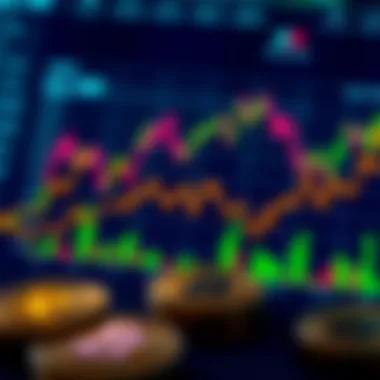Examining the US Dollar and Indian Rupee Exchange Dynamics


Intro
The fluctuating exchange rate between the US Dollar and the Indian Rupee is a crucial point of interest for investors, businesses, and scholars. Understanding this dynamic is about more than just grasping numbers; it's about peering into the intricate web of economics, politics, and global market trends. As currencies shift and sway, they reflect underlying economic realities, responding to factors such as interest rates, inflation, and trade balances.
To truly comprehend this exchange rate's behavior and implications, one must consider various elements that impact its valuation. This exploration is particularly pertinent today, given the increasingly interdependent global economy.
In this article, we will delve into the key factors influencing the US Dollar to Indian Rupee exchange rate, outline historical trends, and discuss the implications for both businesses and investors in these regions. By equipping ourselves with this knowledge, we can better navigate the complexities of currency exchange in today's fast-paced financial landscape.
Prologue to Currency Exchange
Currency exchange is pivotal in the global marketplace, bridging economies and facilitating international trade. In this context, understanding the dynamics of the exchange between the US Dollar and the Indian Rupee is crucial for multiple stakeholders, including businesses, investors, and policy-makers. The ability to convert currencies isn’t merely a matter of numbers; it reflects a complex interplay of economic realities, political climates, and market behaviors. By dissecting this introduction, we set the stage for a deeper exploration into factors that drive these exchange rates and how they impact various sectors.
The Concept of Currency Exchange
Currency exchange involves converting one currency into another, a practice that operates through multiple channels including banks, foreign exchange markets, and brokers. It’s not just a service; it’s a necessity that helps people engage in commerce across borders. The fundamental idea is straightforward: if you want to buy goods from a foreign market, you need the currency of that market. However, the underlying procedures and the mechanisms that govern these exchanges are far from simple. They're influenced by numerous variables ranging from supply and demand dynamics to regulatory environments.
The exchange rate is a price tag for currency, determining how much of one currency you can get for another. It’s affected by a myriad of factors, such as interest rates, inflation, and even geopolitical events. Take for instance the case of US dollar strengthening against the Indian rupee—this can occur due to the economic health of the United States relative to India, or it might stem from broader trends in global finance.
In essence, currency exchange is the heartbeat of international trade and investment, connecting different economies, and impacting everything from travel costs to enterprise profitability.
Importance of Exchange Rates
Exchange rates serve as more than just a conversion tool; they are essential indicators of economic stability and health. A fluctuating exchange rate can alter the landscape for businesses and investors alike. For companies engaged in importing or exporting goods, these rates can significantly influence pricing strategies and profit margins. A stronger dollar, for example, can mean that American goods become more expensive abroad, potentially leading to decreased sales for US exporters.
Moreover, investors keep a keen eye on exchange rate movements as they can have direct implications on the returns of investments made in foreign economies. Fluctuations in the exchange rate may present opportunities for profit, but they also carry risks that need managing.
Consider a tomato producer in India exporting to the US. If the rupee weakens against the dollar, the producer can fetch more rupees per dollar, enhancing profitability. On the contrary, a strong rupee could diminish earnings when converted back to rupees.
"The exchange rate isn’t merely a number; it’s a reflection of a nation’s economic narrative and competitive standing in the world."
In summary, a clear grasp of currency exchange concepts is imperative for anyone involved in international trade or investment. It's the backbone of cross-border relationships and economic interactions, influencing not just transactions but also national policies and individual livelihoods.
Historical Perspective on US Dollar and Indian Rupee
Understanding the historical context of the US Dollar to Indian Rupee exchange rate adds a layer of depth to the analysis of current trends. The fluctuations in this currency pair over the years highlight not only economic conditions but also political landscapes, global interactions, and evolving trade dynamics. By grasping the past behaviors of the exchange rate, investors and businesses can make informed predictions regarding its future movements.
Effectively, the historical perspective serves as a roadmap that helps to navigate the complexities of currency values. It underscores critical turning points and transitions that have led to the present day. For example, periods of high inflation in India or economic booms in the United States provide crucial insights into the underlying factors that drive changes in exchange rates. Understanding these historical elements can also inform risk assessments and investment strategies for stakeholders in both nations.
Early Exchange Rate Trends
In the early days, exchange rates between the US Dollar and Indian Rupee were quite different from the dynamic nature we observe today. Initially, the Indian Rupee was pegged to the British Pound, and when India gained independence in 1947, it traded at roughly 4.76 against the Dollar. This fixed system translated to relative stability, but it also masked underlying economic challenges.
The liberalization of the Indian economy in the early 1990s sparked significant changes in the exchange rate. As the rupee transitioned to a more market-driven mechanism, its value saw substantial fluctuations. For instance, by 1991, the exchange rate had crossed 17 to 1 due to economic reforms and strong demand for foreign currency. Moreover, historical events, such as the 1997 Asian Financial Crisis, also played a role in shaping these early trends. The Indian Rupee was significantly impacted, demonstrating the international dependencies that influenced its value.
These formative years set the stage for how currency traders and investors would approach the USD/INR pair, understanding that the value is not merely a number but a reflection of a broader economic narrative.
Significant Policy Changes
Policy changes often act like a tide, either raising or lowering the value of currencies. Notably, India’s shift to a floating exchange rate system in 1991 marked a watershed moment. Initially, the move was met with skepticism; yet, it led to increased foreign investment and optimism regarding India’s economic potential.
Another significant change came with the Foreign Exchange Management Act of 1999, which liberalized a number of restrictive foreign investment measures. Policies like these play a crucial role in reshaping the nature of investment and monetary flows into India, impacting the rupee’s standing against the dollar. Moreover, initiatives such as "Make in India" and various trade agreements have further highlighted the importance of currency exchanges in economic development.
Reflecting on these past policy shifts helps to provide investors with a comprehensive understanding of how governmental decisions influence exchange rates. These nuances encourage stakeholders to stay informed, as future regulatory changes can very well impact their currency positions.
"The essence of investing lies not just in what the numbers say today, but in understanding the story they tell over time."
In summary, the historical perspective on the US Dollar and Indian Rupee is vital for anyone looking to engage meaningfully with the foreign exchange market. By acknowledging early trends and the effects of significant policy changes, one can better navigate the complexities of currency valuation and its implications for the future.
Factors Influencing Currency Valuation
Currency valuation is a critical concept when examining foreign exchange markets. The performance of any currency, particularly that of the US Dollar against the Indian Rupee, can fluctuate based on an array of interrelated factors. In understanding these factors, investors, economists, and policymakers can anticipate market changes and derive informed decisions.


Economic Indicators
To grasp how the US Dollar relates to the Indian Rupee, we must first delve into economic indicators. These are metrics that provide insights into the health of an economy and often influence trading behaviors. For instance, GDP growth rates, inflation levels, and employment statistics can significantly affect currency valuation.
- GDP Growth Rate: The Gross Domestic Product shows how well an economy is performing. A higher GDP growth rate in India, compared to the US, might strengthen the Rupee in relation to the Dollar, making Indian goods cheaper for Americans.
- Inflation Rates: Inflation is another telling sign. If inflation in India rises faster than in the US, the purchasing power of the Rupee can diminish, leading to its depreciation.
- Employment Figures: Employment is a vital factor. Higher employment levels generally signal a robust economy, which can fortify the currency's strength.
"Understanding economic indicators can be the difference between a wise investment and a regrettable miscalculation."
Overall, these indicators are not standalone entities but rather intermingled data points that reflect economic conditions. Missing a change in even one of these factors could mean missing a potential market shift.
Political Stability and Policies
Political factors also have a bearing on currency valuation. If a country is politically stable, it attracts foreign investments, fostering demand for its currency. Conversely, political strife can deter investment and hence lower currency value.
- Policy Changes: Shifts in governmental policies, such as tax reforms or trade agreements, can impact investor confidence. For instance, if the Indian government announces pro-business policies, this might lead to a rise in foreign investment and thus strengthen the Rupee against the Dollar.
- Geopolitical Events: These events, such as elections or international conflicts, can lead to sudden market responses. A stable political environment is generally favorable for currency strength, while instability may undermine it.
As we can see, the relationship between political stability and currency values is complex but undeniably impactful. Investors need to stay informed about political happenings to gauge their possible effects on currency fluctuations.
Market Speculations
Market speculation is another driving force behind currency valuations. Traders' perceptions can create a self-fulfilling prophecy—if enough believe the Rupee will devalue, they may act accordingly, prompting that very devaluation.
- Trader Sentiment: Market sentiment can be as influential as tangible metrics. If traders expect that the Indian economy will outperform the American one, demand for the Rupee could surge.
- Technological Impacts: With the rise of algorithms and trading bots, market movements can happen rapidly. A sudden influx of sell orders based on speculative news can lead to swift price changes in currency valuation.
Speculative trading is a double-edged sword. It can offer opportunities for profit but also brings about volatility that can disrupt equilibrium in the exchange rates.
By examining economic indicators, political circumstances, and market speculations, we can paint a more holistic picture regarding the valuation of the US Dollar against the Indian Rupee. Understanding these factors is paramount for stakeholders looking to navigate the complexities of currency exchange.
The Impact of Global Events
The exchange rates between the US Dollar and the Indian Rupee do not exist in a vacuum. Their fluctuation is deeply intertwined with global happenings that reverberate across nations. Understanding these international dynamics is crucial, as they can offer valuable insights to investors and businesses looking to navigate currency risks.
Several factors come into play, when discussing the impact of global events on exchange rates:
- Interconnected Economies: The world economy functions as an intricate web. A hiccup in one country can cause ripples, affecting others. For instance, if there is a recession in a major economy like the United States, it can lead to decreased demand for Indian exports, impacting the Rupee.
- Investor Sentiment: Global crises often spur a flight to safety. Investors typically flock towards the US Dollar during turbulent times. This behavior can elevate its value against other currencies, including the Rupee.
- Policy Responses: Actions taken by governments and central banks worldwide can influence exchange rates. When the Federal Reserve takes measures to stimulate the US economy, it might lead to greater capital flows to emerging markets, affecting the Dollar-Rupee relationship.
- Geopolitical Tensions: Events such as military confrontations or diplomatic disputes can create uncertainty, prompting investors to rely on more stable currencies. This shift can cause the Rupee to weaken against the Dollar, as investors seek refuge.
The significance of these global events makes it imperative for anybody involved in currency exchange to remain vigilant and informed about what's happening beyond national borders.
Economic Crises
Crises like the 2008 financial meltdown or the shocks during the COVID-19 pandemic reveal how sensitive exchange rates can be. During these times, currencies may experience extreme volatility. Investors often witness sharp movements in the Dollar-Rupee rates as panic-driven behavior dictates market sentiments.
- Short-Term Impacts: In times of economic downturn, the immediate reaction tends to be harsh devaluations for many currencies. The Indian Rupee, for example, often weakens against the Dollar as capital flows out of India. Investors tend to prefer the relative stability of the Dollar.
- Long-Term Adjustments: While short-term shocks can be dramatic, they often set the stage for subsequent reforms in economic practices. Countries may rethink their fiscal approaches, leading to more resilient financial systems. This adjustment can eventually strengthen the Rupee over time, dependent on how well they implement necessary changes.
"Economic turmoil not only forces a re-evaluation of present situations but also creates opportunities for future growth through resilience."
Trade Agreements and Tariffs
Trade dynamics, shaped by agreements and tariffs, play a significant role in determining the exchange rate between the US Dollar and the Indian Rupee. Trade policies can either bolster or weaken the exchange relationships based on the preferential treatment they offer to each party.
- Effect of Tariffs on Exchange Rates: Imposed tariffs can disrupt trade flows between the US and India, influencing currency values. If tariffs are increased on Indian goods, it may create a trade imbalance, leading to a weaker Rupee as exports shrink.
- Beneficial Trade Agreements: Conversely, a trade agreement that favors cross-border transactions can enhance the strength of the Rupee, making it more attractive for foreign investments. When investors observe a friendly trade environment, they might be more willing to put their money into Indian markets contributing to a stronger currency.
- Global Value Chains: The nature of production in today's world often means that goods in one country might rely heavily on components from another. Therefore, any disruption along these chains, often caused by tariffs or trade agreements, can affect exchange stability and must be closely monitored.
By observing these global events, investors and businesses can better grasp the tendencies in currency values, aiding them in strategic decision-making. Monitoring shifts in economic policies or trade terms now is crucial to anticipating future currency movements.
Investment Strategies Linked to Exchange Rates
When delving into the intricacies of exchange rates, particularly the US Dollar to Indian Rupee route, it’s apparent that investment strategies become paramount. A solid grasp of how currency fluctuations play into investment decisions is vital for anyone dabbling in the financial market or considering cross-border business activities. It’s not just about buying low and selling high; it’s about positioning oneself strategically amidst a landscape that’s ever-shifting due to numerous factors like economic conditions, political climates, and even global events.
The essence of investment strategies linked to exchange rates lies in the significance of understanding the yo-yoing numbers on a forex ticker. These numbers can have broader implications than one might initially assume. Knowing when to enter or exit a position based on currency movements can separate a successful investor from a novice. It's about leveraging the right information at the right time.
Forex Trading Fundamentals
Forex trading serves as the backbone of currency exchange, offering numerous mechanisms for investors to capitalize on fluctuations. Traders typically engage in this market through spot and forward contracts, whereby spot allows immediate exchange while forward involves an agreement to exchange currency at a predetermined rate on a future date. For instance, if an investor anticipates that the Indian Rupee will strengthen against the US Dollar, they might decide to enter a forward contract to lock in current rates.


Understanding the fundamentals also involves grasping the intricacies of trading platforms, types of orders, and reading price charts. Here, technical analysis plays a critical role. Indicators such as moving averages or the Relative Strength Index (RSI) can arm traders with insights about market conditions. In honing these skills, investors can better gauge sentiment and momentum, thus making informed decisions.
"The forex market runs 24 hours a day, making it a dynamic and fluid environment where opportunity abounds."
Risk Management Techniques
Every investor knows that the best-laid plans can go awry. That’s why risk management techniques serve as an essential safety net in any investment strategy regarding currency exchange. For instance, employing stop-loss orders can help mitigate potential losses. By setting predefined exit points, investors can protect themselves from heart-stopping fluctuations that lead to significant downturns.
Another important technique involves diversification. By spreading investments across different currencies, the risk associated with a single currency’s volatility can be reduced. In this way, if the US Dollar dips against the Indian Rupee, investments in another currency may offset that loss. Additionally, utilizing leverage with caution can amplify potential gains, but it's also crucial to understand that it can magnify losses, if things take a turn for the worse.
Other techniques include setting realistic profit-taking strategies and maintaining adequate liquidity. In situations where market volatility escalates, having cash on hand enables an investor to seize new opportunities swiftly.
Market Trends in US Dollar to Indian Rupee Exchange Rate
The exchange rate between the US Dollar and the Indian Rupee is a dynamic indicator of economic relationships, market behaviors, and geopolitical influences. Understanding these market trends is crucial for investors, businesses, and anyone engaged in currency trading or international commerce. The relationship between these two currencies can provide insights not only into investment opportunities but also into the economic health of both the U.S. and India.
Key Factors Impacting Market Trends
- Economic Indicators: Various economic reports, like GDP growth rates, employment data, and inflation figures, can heavily influence exchange rates. These indicators help traders and investors gauge the economic performance of a country, subsequently impacting currency valuation. An uptick in U.S. job growth could strengthen the dollar, while a slump in Indian manufacturing might weaken the rupee.
- Political Developments: Policies and political stability play a critical role. Changes in government, unexpected reforms, or even regional instability can result in currency fluctuations, revealing immediate reactions in the forex markets. Investors must stay informed about political trends in both countries as these can lead to swift changes in exchange rates.
- Market Sentiment: Speculation can drive significant movements in currency values. Traders’ perceptions often shift based on current events or media reports, leading to either bullish or bearish trends in exchange rates.
"Exchange rates are not merely numbers displayed on a screen; they reflect the real-time economic pulse of nations involved in trade and investments."
Benefits of Analyzing Market Trends
- Informed Decision-Making: Understanding the market trends allows investors to make educated decisions whether to buy, sell, or hold their currency assets.
- Investment Strategy: Tailoring investment strategies based on predicted trends can maximize returns while minimizing losses. For example, if trends indicate a strengthening USD, investors may adjust their holdings accordingly.
- Risk Management: Awareness of market trends can help in establishing stop-loss orders or hedging strategies to protect against volatile market movements.
Current Exchange Rate Analysis
As of the latest data, the exchange rate between the US Dollar and the Indian Rupee reflects a complex interplay of domestic and international factors. The USD has generally been seen as a safe haven amid global uncertainties, which has led to its appreciation against the Rupee. Several contributing elements need to be highlighted:
- Recent Historical Performance: Over the past few months, fluctuations can be traced back to shifting economic reports from both countries. The dollar's strength has, to some degree, been fueled by robust U.S. payroll numbers and manufacturing data, contrasting with India's slower economic recovery from the pandemic.
- Political and Economic Events: Events such as India's fiscal policies, central bank meetings, and external trade agreements have provided impetus for changes in the exchange rate. These events may lead to temporary contractions or expansions in the USD/INR dynamic.
Current Rate Trends include fluctuations where the dollar has experienced a considerable high recently. It's vital for traders to closely observe these movements and understand when potential reversal points might happen.
Forecasting Future Trends
Looking ahead, predicting the USD to INR future trends requires consideration of several vital elements:
- Global Economic Outlook: The state of the global economy, particularly post-pandemic recovery, will be a significant determinant. Should the U.S. economy continue to strengthen and India addresses structural economic challenges effectively, the exchange rate dynamics may shift.
- Monetary Policy Changes: Both the Federal Reserve and the Reserve Bank of India play critical roles in currency valuation through interest rate adjustments. Any change in their monetary policies can lead to significant impacts on exchange rates.
- Emerging Market Trends: With India being one of the fastest-growing economies, changes in market conditions, trade partnerships, or foreign investment flows can influence perceptions of the Rupee's strength.
There is substantial disagreement among analysts about the trajectory of this currency pair, thus it's advisable for investors to continually educate themselves and monitor economic sentiment to navigate the currency exchange landscape effectively.
The Role of Technology in Currency Exchange
The rapid shift in the landscape of currency exchange is significantly shaped by technology. As businesses and investors further integrate digital solutions into their operations, understanding the technological aspects becomes paramount. This section dissects how advancements, particularly in blockchain and fintech, are transforming the traditional mechanisms of currency exchange.
Blockchain and Digital Currencies
Blockchain technology is not just a buzzword; it's fundamentally altering how we perceive and conduct transactions. At its core, blockchain serves as a decentralized ledger that records all transactions across multiple computers. This means that once a transaction is validated, it is nearly impossible to alter it, enhancing trust and transparency.
In the context of currency exchange, blockchain offers several compelling advantages:
- Lower Transaction Costs: By eliminating intermediaries and utilizing peer-to-peer networks, transaction fees can be drastically reduced.
- Speed of Transactions: Traditional money transfers can take days to process, especially across borders. Blockchain can facilitate instantaneous exchanges, allowing greater liquidity in currency markets.
- Secure Transactions: With cryptographic security measures, the risk of fraud and cyberattacks is diminished. This boost in security is crucial for investors and businesses dealing in large volumes of currency.
- Increased Access to Financial Services: Blockchain technology can empower individuals in developing countries, offering them unprecedented access to the global currency market.
Cryptocurrencies, the most well-known application of blockchain, are also disrupting traditional currency exchange. While Bitcoin and Ethereum are at the forefront, numerous altcoins are emerging, each with unique features tailored for specific purposes. Investors are increasingly looking at these digital currencies as potential vehicles for exchange, judging by their volatility and liquidity.
"Blockchain technology is not a smart techy gadget; it can reshape our economic interaction fundamentally."
Fintech Innovations
The fintech revolution has introduced new players into the currency exchange game, providing users with tools that were previously inaccessible. By leveraging advanced algorithms, artificial intelligence, and real-time data analytics, fintech companies are enhancing the user experience in currency exchange.
Some key innovations include:


- Mobile Applications: The rise of mobile trading apps like TransferWise and Revolut has democratized cross-border transactions. Users can now convert currencies on their smartphones, with real-time exchange rates at their fingertips.
- Automated Trading Systems: These platforms utilize algorithms to execute trades based on preset conditions, enabling faster and more effective currency purchases. This appeals particularly to traders looking to capitalize on short-term fluctuations in exchange rates.
- AI-Powered Insights: Many fintech firms now offer analytics based on big data, providing insights into currency trends and helping investors make informed decisions regarding when to buy or sell.
- Integrated Solutions: Platforms that combine payment solutions with currency conversion enhance overall efficiency, allowing businesses to manage international invoices seamlessly.
The result of these innovations is a landscape that is more user-friendly and responsive to market changes, which will likely influence the US Dollar to Indian Rupee exchange rate significantly in the coming years.
By embracing these technological advancements, investors and businesses can navigate the complexities of currency exchange better, preparing themselves for a future where technology plays an even more crucial role.
Cross-Border Transactions and Currency Exchange
Cross-border transactions play a pivotal role in the landscape of currency exchange, particularly between the US Dollar and the Indian Rupee. With globalization at the forefront of economic activity, understanding how these transactions function can reveal much about current trends and future outlooks. These exchanges are not just about numbers; they're transactions that can affect economies, investments, and daily lives. When businesses and investors engage in cross-border activities, they must navigate a myriad of considerations that surround the conversion of currencies.
Challenges in Currency Conversion
Currency conversion might seem straightforward, but various challenges can complicate the process. One of the most pressing issues is the exchange rate volatility. Fluctuations can be influenced by a range of factors including economic policies, market speculation, and global events. For example, a sudden economic crisis can lead to unexpected shifts, causing losses for those who haven’t hedged their investments properly.
Additionally, regulatory barriers can pose significant hurdles. Different countries have varying regulations surrounding foreign exchange transactions. This can lead to delays, unexpected fees, or even restrictions that prevent timely currency conversion. For businesses operating across borders, such considerations need to be factored into their financial planning.
Another challenge is the fees involved in currency exchange. Banks and exchange services often impose high fees, which can accumulate and eat into profits. Moreover, utilizing informal channels or relying on technology for exchange can come with its own set of risks, from fraud to compliance issues. An emphasis on transparency and security is essential to mitigate these issues.
Best Practices for International Transfers
When it comes to international transfers, adopting best practices can lead to smoother transactions and ultimately save money. Here are some strategies that individuals and businesses can adopt:
- Choose the Right Provider: Selecting a trustworthy forex provider can make all the difference. Comparing rates and fees from various platforms—like banks, fintech apps, and exchange companies—provides options that can save significant costs.
- Utilize Automated Solutions: Leveraging technology can streamline the conversion process. Automated systems and platforms can offer real-time rates and facilitate quicker transactions. Tools like Wise or Revolut can be especially advantageous for cross-border payments.
- Timing the Market: Monitoring exchange rates and timing transactions strategically can yield better rates. Engaging in market analysis through financial news outlets or dedicated trading platforms can help in making informed decisions.
"Understanding the intricacies of currency exchange is crucial for anyone engaging in cross-border transactions, whether for investment or daily business operations."
- Plan for Regulatory Compliance: Staying informed about the legal requirements of currency exchanges in different jurisdictions is essential. This includes understanding tax implications and ensuring compliance with anti-money laundering regulations.
In summary, cross-border transactions encompass more complexity than one might initially perceive. With the right approach, individuals and businesses can navigate the challenges posed by currency conversion while taking advantage of the opportunities presented in the vast global marketplace.
The Future of USD to INR Exchange Rates
The future trajectory of the exchange rate between the US Dollar (USD) and the Indian Rupee (INR) is both a fascinating topic and a matter of significant consequence for a multitude of stakeholders. As this relationship unfolds, it shapes not just investment strategies, but also broader economic initiatives, trade dynamics, and international relations. Understanding the factors driving these future exchange rates is crucial for investors, technologists, educators, and entrepreneurs alike. Knowledge of these elements allows for informed decisions, ultimately leading to sustainable growth within their respective fields.
Potential Economic Shifts
The economic landscapes of both the United States and India are subject to a variety of shifting dynamics. These dynamics can alter the way currencies relate to one another. In the US, potential shifts could arise from changes in monetary policy decisions made by the Federal Reserve. Should the Fed decide to increase interest rates to combat inflation, the attractiveness of the USD may rise, potentially strengthening its position against the INR.
On the Indian side, economic reforms aimed at fostering foreign investment could have an opposite effect. For instance, simplifying regulations might enhance business environments and lead to an influx of capital, which in turn could boost the INR's value. Furthermore, India’s own policy shifts, including initiatives in technology and manufacturing, could strengthen its economic foundations, offering better long-term prospects for the INR.
These potential shifts create a scenario where economic stability plays a crucial role. For investors, awareness of these shifts provides imperative insight into future decisions, from stock market investments to currency trading. As both economies navigate challenges—whether it be trade deficits, inflation, or geopolitical tensions—the interconnected nature of these economies means each pivotal shift could significantly impact the exchange rate dynamics.
Impact of Global Policies
International policies have a profound influence on the future of USD to INR exchange rates. Geopolitical relations, trade agreements, and regulatory frameworks established by bodies like the World Trade Organization affect global trade flows and, subsequently, currency values. Should the US and India engage in revised trade agreements, these modifications might either bolster or weaken their currencies depending on the stipulations of the agreements.
For example, if new tariffs are imposed on goods traded between the two nations, it could lead to a depreciation of the INR relative to the USD, as market participants respond to the altered trade balance. On the flip side, cooperative policies that encourage bilateral investments may nurture a healthier exchange rate. The way that global policies evolve will remain a key factor in determining the future strength of both currencies.
"Understanding the interplay of global economic policies is essential for predicting exchange rate movements. Investors must stay vigilant and informed."
Future exchange rates between the USD and INR hinge on both economic shifts and global policies. Therefore, comprehensive monitoring of these factors not only provides insight but also facilitates strategic planning in investments and business ventures. The ongoing interplay among these elements signifies that the landscape of currency exchange remains complex and ever-evolving, reminding us of the significant role economics plays in our interconnected world.
Finale
The conclusion serves as a vital part of this article, as it encapsulates and reflects on the myriad elements that have been discussed regarding the interplay between the US Dollar and the Indian Rupee. In a global economy, understanding this currency exchange is not merely academic—it directly impacts investors, businesses, and consumers alike. It is of utmost importance to recognize how fluctuations in exchange rates can affect trade balance, investment decisions, and even inflation rates.
Summarizing Key Insights
As we wrap up our discussion, several key insights emerge:
- Historical Context: The trajectory of the US Dollar and Indian Rupee exchange rate shows patterns influenced by economic policies, trade agreements, and geopolitical events. Historical context provides a roadmap for understanding current trends.
- Economic Indicators: Factors such as inflation rates, GDP growth, and interest rates create a robust framework to evaluate the strength of a currency. Economic data is not just numbers; it's a reflection of the country's overall health.
- Market Dynamics: Speculative trading, political stability, and global economic shifts shape how investors approach currency trading. Being aware of these dynamics can give investors a leg up in making informed decisions.
By synthesizing these insights, we can see that the convergence of USD to INR is an ongoing story with multiple narratives entwined together, and investors must stay alert to navigate this complex landscape.
Final Thoughts on Currency Exchange Dynamics
Understanding the dynamics of currency exchange, particularly between the US Dollar and the Indian Rupee, offers investors and businesses substantial benefits. As the world becomes increasingly interconnected, the significance of currency valuation cannot be understated. Awareness of shifting exchange rates allows for better risk management and strategic planning in international dealings.
It’s essential to keep an eye on both macroeconomic indicators and market sentiments. As policies change and global events unfold, predictions may hold water for only a while, so being adaptable is crucial. Significant market movements often arise from unexpected news rather than established data.



